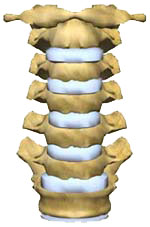The cervical spine is designed to handle a great deal of stress; however, there are a number of degenerative changes that can take place in the vertebrae and discs, resulting in neck pain and other symptoms.
 Neck pain and other symptoms caused by a cervical (neck) spine disorder are a very common problem for many adult Americans. The neck, or cervical spine, is made up of seven vertebrae separated by shock-absorbing intervertebral discs and supported by muscles and ligaments, and also is rich in spinal nerves and nerve roots.
Neck pain and other symptoms caused by a cervical (neck) spine disorder are a very common problem for many adult Americans. The neck, or cervical spine, is made up of seven vertebrae separated by shock-absorbing intervertebral discs and supported by muscles and ligaments, and also is rich in spinal nerves and nerve roots.
When you feel pain, it’s a reaction to signals transmitted throughout your body. These signals are sent from the pain source through the nerves in the spinal cord and into the brain, where they are perceived as pain. In addition to causing neck pain, problems that originate in the cervical spine may result in pain and other symptoms, such as tingling, numbness and muscle weakness, which extend into the shoulders, arms and hands.
Acute Pain vs. Chronic Pain
Acute pain is commonly described as sharp and severe; it tends to come on suddenly but also improve with time and short-term conservative treatment, such as medication, exercise, physical therapy or rest.
 Chronic pain is commonly described as a deep, aching, dull or burning pain, and may be accompanied by numbness, tingling and/or weakness that extends into the extremities. Chronic pain tends to last a long time and is not relieved by conservative care.
Chronic pain is commonly described as a deep, aching, dull or burning pain, and may be accompanied by numbness, tingling and/or weakness that extends into the extremities. Chronic pain tends to last a long time and is not relieved by conservative care.
What’s causing my neck pain?
The intervertebral discs of the cervical spine are very important for the normal mobility and function of your neck. Over time, age, genetics and everyday wear-and-tear can contribute to deterioration of these discs, which, when healthy, act as “cushions” for the individual bones of the spine, or vertebrae.
Each disc is made up of two parts:
- The nucleus pulposus – the soft, gel-like center of the disc.
- The annulus fibrosis – strong, fibrous outer ring that surrounds and supports the nucleus pulposus.
 Over time, intervertebral discs can become dried out, compressed or otherwise damaged, due to age, genetics and everyday wear-and-tear. When this happens, the nucleus pulposus may push through the annulus fibrosis. Disc degeneration also may result in bone spurs, also called osteophytes, or spinal stenosis, the narrowing of the area of the spine where the nerve leaves the spine and travels to the rest of the body.
Over time, intervertebral discs can become dried out, compressed or otherwise damaged, due to age, genetics and everyday wear-and-tear. When this happens, the nucleus pulposus may push through the annulus fibrosis. Disc degeneration also may result in bone spurs, also called osteophytes, or spinal stenosis, the narrowing of the area of the spine where the nerve leaves the spine and travels to the rest of the body.
If disc or bone material pushes into or impinges on a nearby nerve root and/or the spinal cord, it may result in pain, numbness, weakness, muscle spasms and loss of coordination, both at the site of the damage and elsewhere in the body, since most the nerves for rest of the body (e.g., arms, chest, abdomen and legs) pass from the brain through the neck.
These symptoms and the conditions that cause them are collectively referred to as degenerative disc disease, if the condition has become chronic over time. Similar symptoms, however, may occur suddenly if the disc nucleus dislodges acutely and causes nerve root compromise, a condition referred to as a herniated disc.

